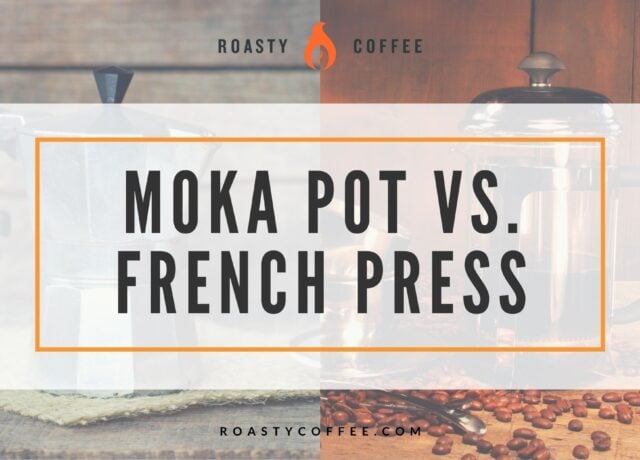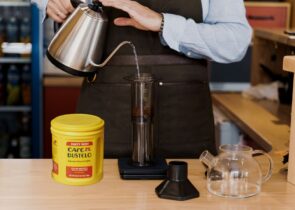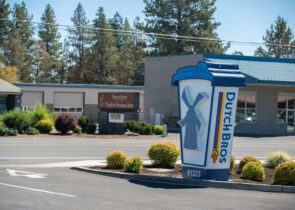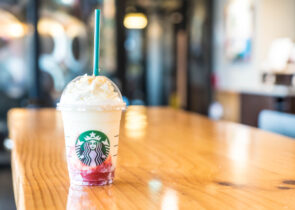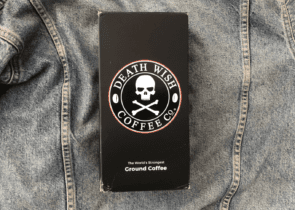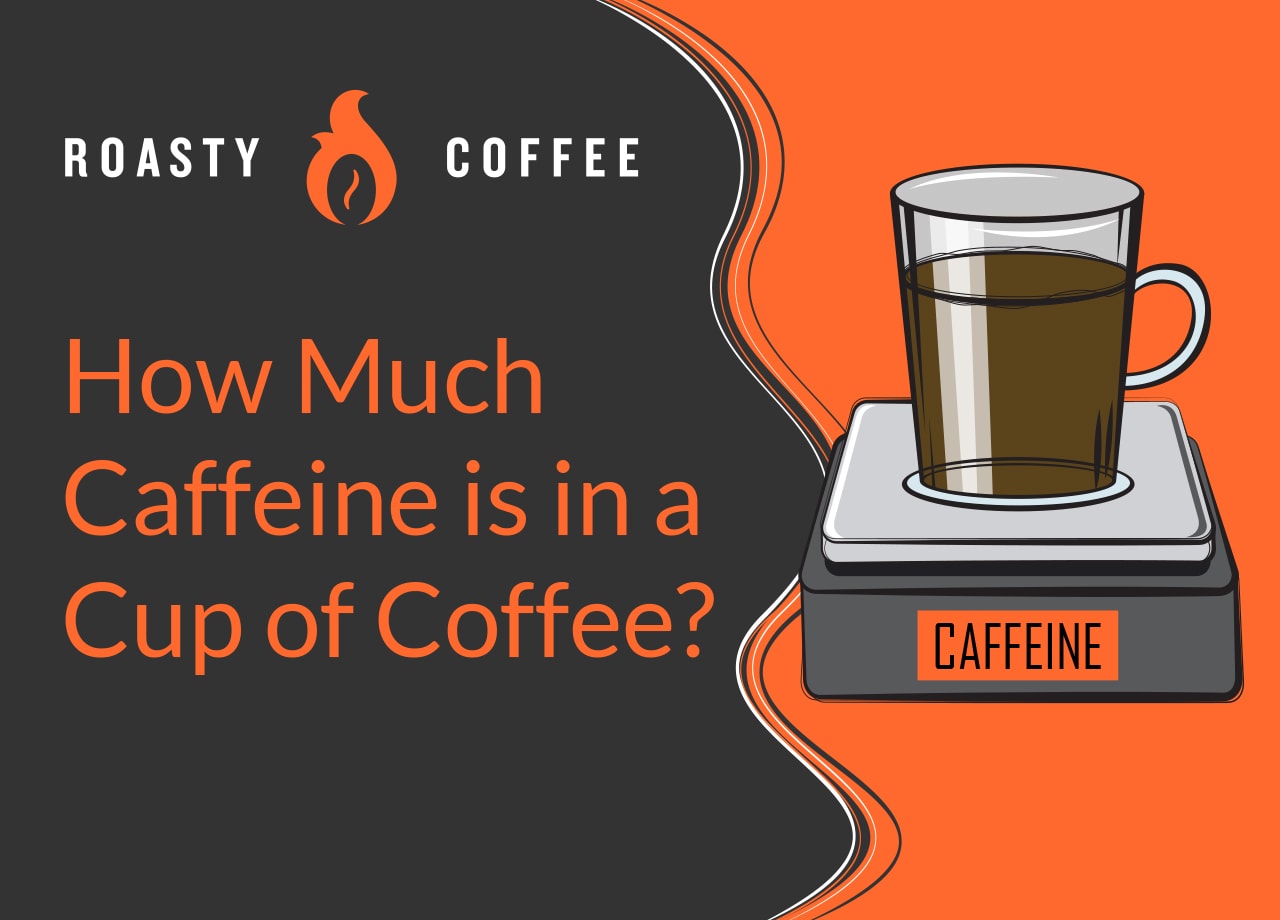
Is a cup of coffee the only thing that can wake you up and get you going in the morning? You’re not alone; many people depend on the caffeine in our favorite beverage for a jolt of energy every day, including all of us here at Roasty. But, given our passion for brewing great joe, you probably already knew that.
Now, have you ever considered just how much caffeine is in that cup of coffee you’re gulping down? Sure, you know there’s at least enough of the stimulant in your joe to keep your eyes open during your commute, but that’s not very specific, is it?
Well, we’ve got the answers you’re searching for, plus information about how the stuff can affect your body. Read on to find out more!
What Is Caffeine?
We should probably explain what caffeine is before we shed a little light on the differences in caffeine content of your favorite coffee drinks.
Simply put, caffeine is a stimulant drug found in various beverages that act as an energizing pick-me-up for your central nervous system, heart, and muscles. Though it occurs naturally in coffee beans, caffeine can be added to things like fizzy soft drinks or popular energy drinks (like Red Bull, for example), too.
Unlike many drugs, there is no stigma around regular caffeine consumption. It’s estimated that about 90 percent of the American population has a few milligrams of caffeine, whether through a few cups of coffee or some other source, every single day!
How Much Caffeine is in a Cup of Coffee?
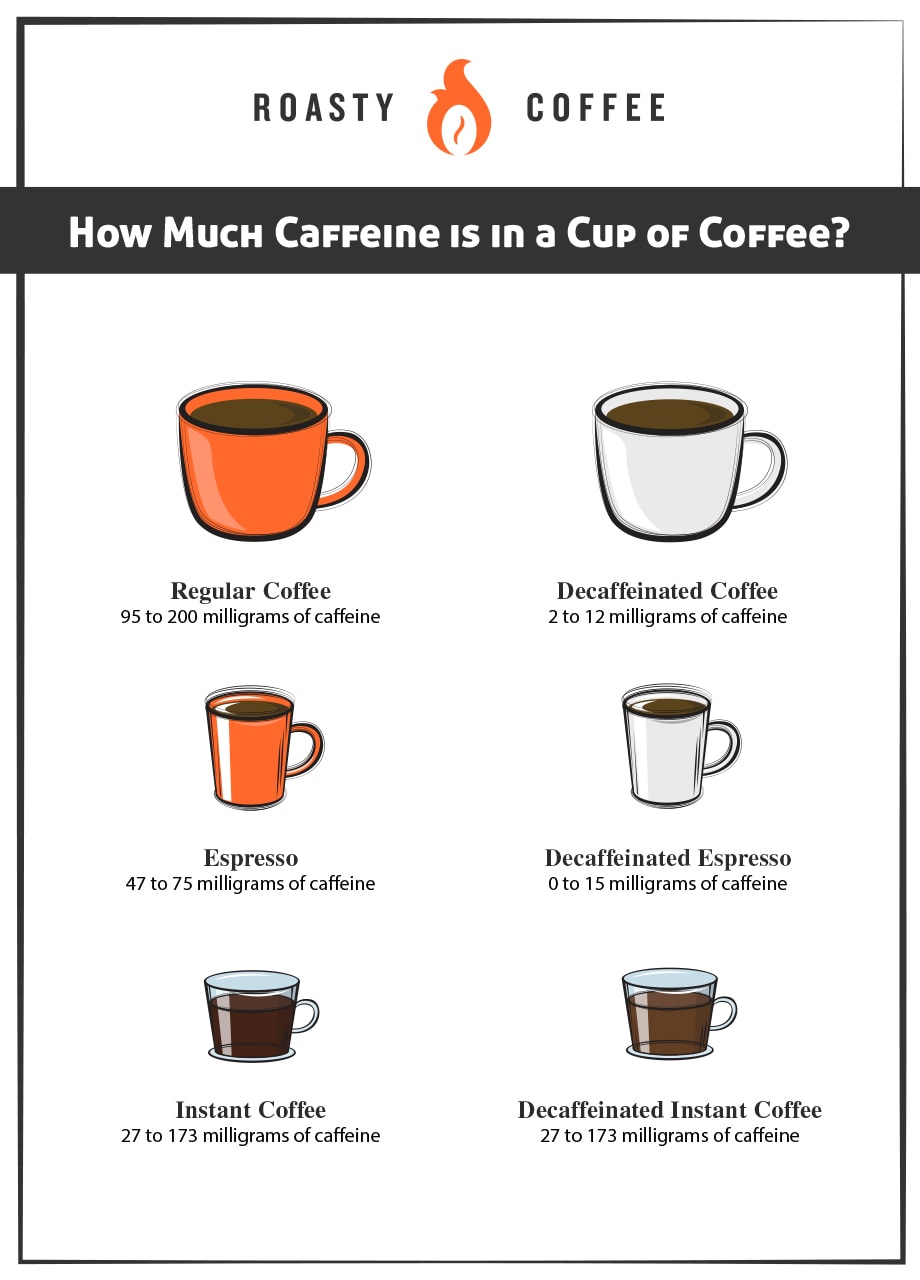
All right, back to the question of the hour: how much caffeine is in a cup of coffee?
The answer depends on a few different factors, like the type of coffee beans used and how they’re brewed. We’ll dig deeper into those a little later on, but for now, we’ll give you a quick breakdown of the differing amounts of caffeine in some of the most popular kinds of joe.
A quick note before you read further: these amounts are based on an 8-ounce cup, except the espresso shot. That’s based on a 1-ounce serving, as that’s the typical amount of the rich, dark joe used in an espresso-based drink.
- Regular Coffee: 95 to 200 milligrams of caffeine
- Decaffeinated Coffee: 2 to 12 milligrams of caffeine
- Espresso: 47 to 75 milligrams of caffeine
- Decaffeinated Espresso: 0 to 15 milligrams of caffeine
- Instant Coffee: 27 to 173 milligrams of caffeine
- Decaffeinated Instant Coffee: 27 to 173 milligrams of caffeine
Figures adapted from Journal of Food Science, 2010; Pediatrics, 2011; Journal of Analytical Toxicology, 2008; USDA National Nutrient Database for Standard Reference, Release 26; Journal of Analytical Toxicology, 2006; Starbucks, 2014; Food and Chemical Toxicology, 2014.
As you can see, an 8-ounce mug (or 1-ounce shot) of joe doesn’t have too much caffeine. If you’re downing a whole pot of the stuff every day, however, that’s a different story, and those milligrams start adding up. If you’re limiting yourself to just one or two cups of coffee per day, however, you should have nothing to worry about.
You probably also noticed that even decaf coffee contains a little bit of the stimulant drug. Don’t let that dissuade you from purchasing decaffeinated varieties of coffee beans, though; most of them have a caffeine level that’s so low, only those who are highly sensitive to the compound would experience any effects.
What affects the amount of caffeine in coffee?
There will be a difference in caffeine content in every cup of coffee you drink. This fluctuation has three primary causes:
- Variations in the coffee bean blend
- The amount of ground coffee used during brewing
- Brewing method
Breaking Down the Bean
When we say variations of the coffee bean blend, we’re primarily referring to their species (arabica and robusta coffee beans are the most common), roast level, and grind.
Coffee Species
Most coffee lovers know there are many species of coffee out there, but what they may not know is that each of them contains different levels of caffeine.
Though arabica is the most common species of the coffee plant in the world today (70 percent of the world’s joe uses these beans), these kinds of beans don’t have as much caffeine as other species do.
For example, the second most common species, robusta, boasts almost twice the amount of caffeine as arabica. That’s why many brands of coffee known for providing an extreme caffeine boost (think Death Wish) include robusta beans in their blends.
Roast Level
Did you know that dark roast coffee has a different amount of caffeine than a lighter roasted bean?
When you roast a green coffee bean, it loses water and expands in size. But something else happens during the process as well. The density of the bean changes, so those that stay in the coffee roaster longer are less dense. This means that, depending on how you measure your joe, lighter roasts have more caffeine than their darker counterparts (this is true if you measure in scoops).
The change in caffeine levels here is so minimal, though, that you probably won’t even notice a difference.
Grind Size
Believe it or not, when you’re brewing ground coffee beans, grind size affects not only the method you’re using but the amount of caffeine present in your final brew, too.
You know that the coffee flavor is extracted as the hot water passes through the grinds, so it should come as no surprise to hear that caffeine is, too. Finer ground coffee has more surface area than coarser joe, allowing more caffeine to be extracted as it brews.
Coffee Brewing Techniques
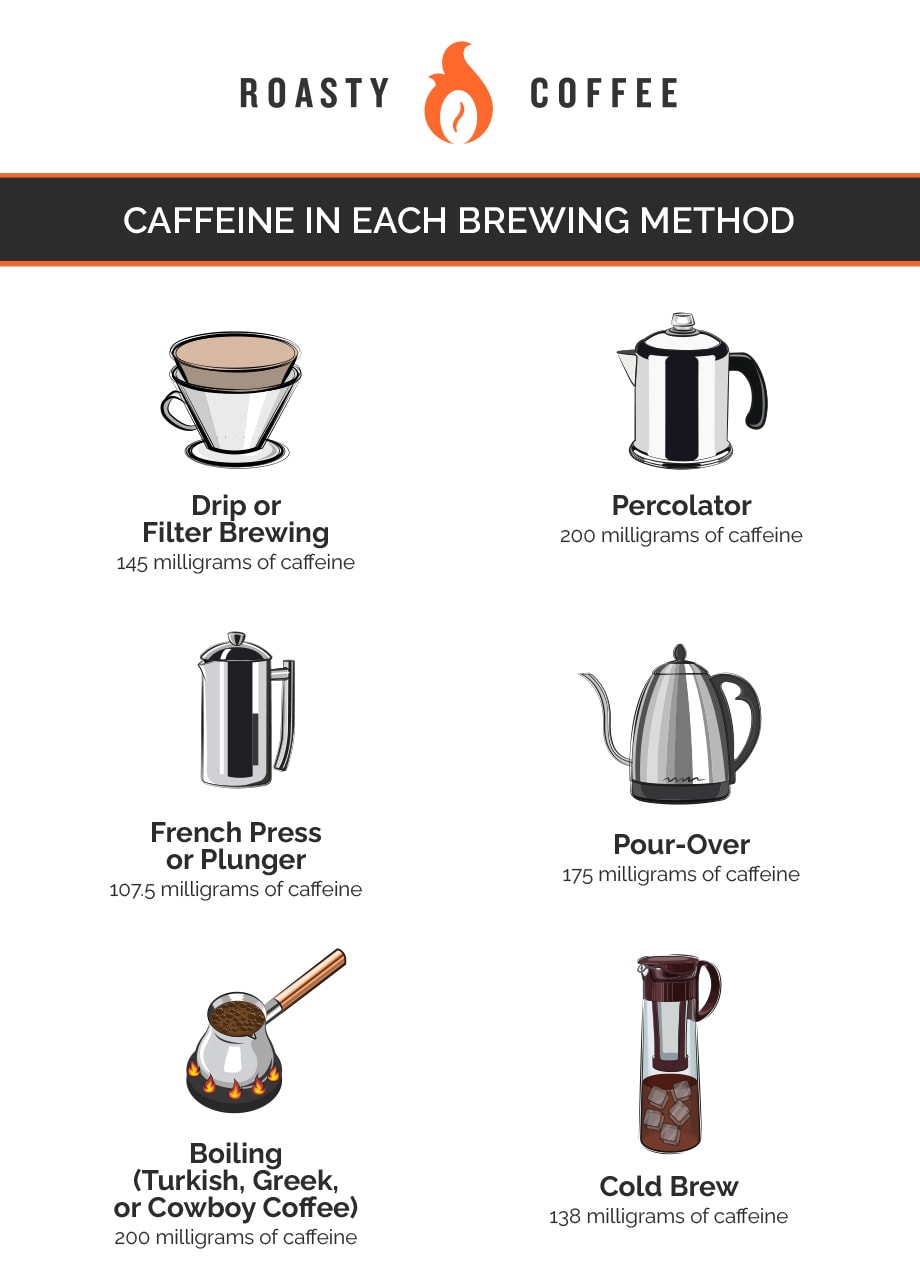
Now, onto the brew! You can use several different brewing methods to fill your coffee cup, and each one can impact precisely how much caffeine ends up in your brewed joe. Some of the most commonly used brewing methods and their average caffeine levels (based on an 8-ounce serving) are as follows. Remember, however, that these amounts can fluctuate.
- Drip or filter brewing: 145 milligrams of caffeine
- Percolator: 200 milligrams of caffeine
- French press or plunger: 107.5 milligrams of caffeine
- Pour-Over: 175 milligrams of caffeine
- Boiling (Turkish, Greek, or cowboy coffee): 200 milligrams of caffeine
- Cold Brew: 138 milligrams of caffeine
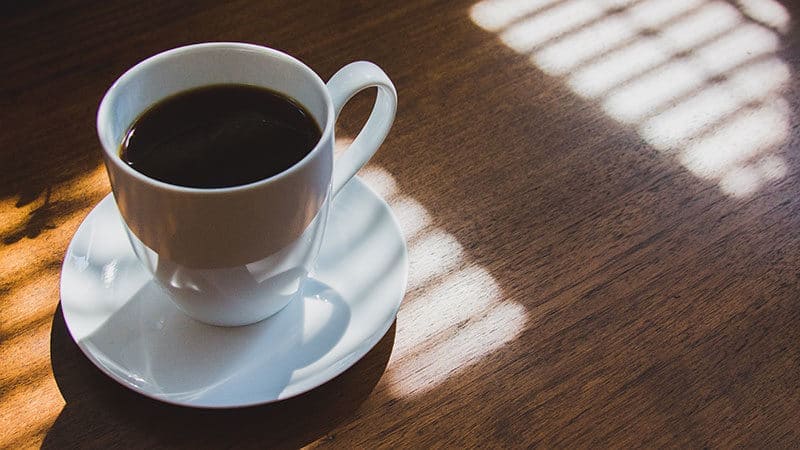
Water
Your water is another huge factor in determining your drink’s caffeine content, regardless of the method of brewing you used to make it.
Hot water between 195 and 205 degrees Fahrenheit extracts much more caffeine than water at different temperatures would, which is why cold brew coffee packs a much weaker dose of caffeine than hot-brewed coffee.
Regular Coffee vs. Espresso
Let’s address the elephant in the room: espresso drinks. You’ve probably heard that despite being served in a smaller serving than other coffee products, a shot of espresso contains more caffeine than them all. So, what’s the deal? Is it true that a shot of this stuff can perk you up more than an 8-ounce cup of coffee can?
If you measure the caffeine content of your coffee by the ounce, then yes, our dark roasted coffee friend, espresso, is the clear winner. Most espresso contains between 45 and 75 milligrams of caffeine per ounce, and when compared to a regular cup of drip coffee’s mere 20 milligrams of caffeine per ounce, it’s clear which type of joe gives you a bigger caffeine bang for your buck.
Though espresso does have more caffeine per ounce, your daily dose of caffeine will be more potent if you down an extra-large cup of drip.
How much caffeine is in espresso?
As we mentioned before, standard shots of espresso, which are about one fluid ounce each, contain 45 to 75 milligrams of caffeine. But serious coffee connoisseurs know the rich joe is served in many different variations, which poses the question: does the caffeine level change when you start tweaking how you pull the shots? Let’s find out!
Doppio
First up is the doppio. The name might seem a bit odd, but it just means you’re getting a double shot of espresso — two ounces instead of one. It’s the default espresso serving size of many coffee shops.
As far as the caffeine content is concerned, a doppio gives you an average of around 150 milligrams.
Lungo
This isn’t Roasty’s first mention of the lungo, but in case you’re out of the loop, here’s the rundown: a lungo is simply a “long” espresso shot, meaning it’s brewed with the same amount of grounds as a standard shot but twice as much water.
Many might think more coffee equals more caffeine, but that’s not necessarily the case with this drink. Because caffeine is one of the first compounds to dissolve during extraction, the slightly longer brew time would only increase the caffeine content by a negligible amount, if at all.
Ristretto
Last but certainly not least is the ristretto. It’s the lungo’s opposite, made with the usual amount of coffee grounds but half as much water, resulting in a more concentrated brew. Despite the more robust taste, a ristretto tends to have the same amount of caffeine as a standard shot.
However, people generally sip a couple of these in one sitting. Because there is an equal amount of caffeine contained in a smaller volume, an ounce of ristretto will have more caffeine per ounce than a regular shot.
Our Favorite High-Caffeine Coffee Brands
If you’re shopping around for a new blend of coffee with enough caffeine to give you a much-needed kick in the pants every morning, we strongly recommend you check out our article on the strongest coffees here. But if you don’t feel like reading about our favorite strong coffee choices, we’ll give you a quick rundown. Our favorite high-caffeine coffee brands are Death Wish Coffee (about 60 milligrams of caffeine per ounce), Biohazard Coffee (77 milligrams per ounce), Banned Coffee (39.5 milligrams per ounce), and Shock Coffee (26.6 milligrams per ounce).
How Caffeine Affects the Body
Time for a little science lesson! Stick with us; it’s interesting, we promise!
A complex network of chemical signals governs every process in our body, two of the most important being hormones and neurotransmitters. Caffeine produces its effects on the body by altering the actions of a few of these chemicals.
The first thing caffeine does is bind itself to the adenosine receptors throughout the brain and nervous system. These receptors act as inhibitory neurotransmitters, which means they suppress the activity levels of the neurons that interact with them. When caffeine binds itself to these adenosine receptors, it prevents them from performing the action they’re designed to do; promoting sleep and relaxation and suppressing arousal.
Once the caffeine suppresses adenosine function, a cascading effect starts within the body and alters the function of other hormones and neurotransmitters.
The most significant impact is on our adrenal glands that produce and secret epinephrine and cortisol. These are the “flight” or “fight” hormones used to increase your heart and respiration rates while also causing smooth muscles to relax.
Caffeine has been proven to increase your body’s epinephrine by as much as 250 percent. In other words, caffeine produces a stress response. Caffeine also increases the circulation of serotonin in parts of the nervous system, elevating your mood and energy levels.
The Benefits of Caffeine
- Morning wake-up call: Sometimes, it’s hard to get going in the morning. That’s where a cup of coffee comes in! The little caffeine jolt it provides can help jumpstart your system and prepare you for the day ahead.
- Improved athletic performance: Studies have found that the stimulant can help athletes improve their endurance and muscular power, leading to better training sessions and greater strength, fitness, and performance gains.
- Improved cognitive performance: The caffeine in a cup of coffee can not only aid your physical power but brain power, too! Short-term memory and systems processing have also improved in individuals who consume low to moderate amounts of caffeine.
The Problems with Caffeine
- Addictive: Caffeine is addictive, and over time your body will become so accustomed to your regular caffeine intake that if you suddenly stop drinking it, your body will be thrown off its normal balance. Your body will continuously break down hormones by binding caffeine to them, leading to many of the same withdrawal symptoms experienced by those who quit drinking.
- Decreased levels of vitamins and minerals: Regular caffeine consumption can suppress your body’s iron function and decrease its level of B vitamins. In extreme cases, this can lead to anemia while reducing your body’s ability to produce the hormones and neurotransmitters that caffeine binds with when it enters your body.
- Intense adverse side effects: It’s not uncommon for you to experience negative side effects like insomnia, nausea, vomiting, stomach irritation, restlessness, nervousness, headache, anxiety, chest pain, or agitation after consuming excessive amounts of caffeine
Better Understand Caffeine and Your Body
One of the most important things for you to remember is that how you react to the caffeine in a cup of coffee depends on your unique body. The stimulant drug isn’t a one-size-fits-all thing; some of us can handle more of it than others.
Sure, a bad reaction to it could fade over time — the more often you drink it, the more of it your body can process before any side effects appear — but even then, it’s important to know your limits and be aware of all the ways caffeine could make things worse instead of better.
Maximize Benefits, Minimize Harm
Now, if the positives above have convinced you to make caffeinated products a permanent fixture in your life, you’ll appreciate the following tips. They’ll help you make the most of the stuff while minimizing the chances of any harm it can cause.
Don’t Use Caffeine Every Day
Cue the sound of every daily coffee drinker letting out an appalled gasp. We know, and we hate this one, too, but it’s the best way to limit your intake. If you simply must continue sipping on one of the many sources of caffeine out there, try to limit yourself to just one cup a day.
Find The Right Dose
When you’re concerned with your caffeine intake, it’s crucial to figure out just how much coffee drinking you can safely do in one day. If your daily coffee intake is so high that you constantly find yourself with the jitters, you have exceeded your limit. On the other hand, if you’re still sleepy after you gulp down your morning joe, you probably aren’t drinking enough to experience any of the energizing caffeine effects.
Try Alternatives to Caffeine
Coffee may be your beverage of choice, but it’s not the only thing out there that contains traces of the stimulant.
Cacao, or unprocessed chocolate, contains a compound that’s related to caffeine but doesn’t interact with the nervous system. Instead, it stimulates blood flow throughout the body, and because your circulatory system can bring more nutrients to your brain, you’ll feel more alert and energized.
Tea is another trusted and familiar source of caffeine, and most varieties have smaller caffeine doses than the standard cup of joe.
Frequently Asked Questions About Caffeine
Should you cut down your caffeine intake?
Of course, we aren’t doctors, so if you’re worried about how much coffee you’re drinking every day, we suggest you consult with your physician. If you’re drinking one or two pots of joe every day, though, one doesn’t have to be a doctor to tell you it’s probably a good idea to dial it back a notch or two.
Does adding milk to coffee reduce its caffeine content?
Latte and café au lait lovers, rejoice! Your milky brew contains just as much caffeine as black coffee or espresso! It does dilute it, though, so you’ll end up consuming less caffeine per sip.
Can you flush caffeine out of your system?
Many baristas and self-diagnosed caffeine addicts swear you can quickly rid your body of the stimulant by chugging large amounts of water. And while hydration is always a good idea, we’re sorry to say it won’t flush the caffeine out of your system. Nothing actually will; you have to wait until its effects wear off naturally.
How long until caffeine is completely out of your system?
Caffeine’s half-life is somewhere between five and six hours, though the exact time the stimulant remains in your body varies depending on genetics. Generally, though, you can expect caffeine to stay in your body for about 10 hours.
How long before bed should you stop drinking caffeine?
According to the Sleep Foundation, you shouldn’t consume caffeinated products within six hours of your bedtime. But this, of course, varies, as caffeine affects everyone differently. If you find that six hours of caffeine abstinence isn’t enough, try cutting off your caffeine intake a few hours earlier. On the other hand, if you’re less sensitive to the stuff, you may be able to get away with having a cup of coffee less than six hours before you fall asleep.
How much caffeine is in Starbucks’ coffee? What about McDonald’s or Dunkin’?
If you prefer hitting up the Starbucks, McDonald’s, or Dunkin’ Donuts drive-thru to get your daily coffee fix, we’ve got you covered. We’ve compared the caffeine levels of a medium-sized cup from each franchise — that’s 16 ounces for McDonald’s and Starbucks, and 14 for Dunkin’. And, while these numbers may vary a bit, hopefully, they’ll give you a better idea of how much of an energy boost you’ll get from each business’s brew.
- McDonald’s Premium Roast: 145 milligrams
- Starbucks Coffee Pike Place Roast: 310 milligrams (Note: this is the Pike Place Roast!)
- Dunkin’ Original Blend: 210 milligrams
The Bottom Line
For most of us, drinking coffee or any other caffeinated beverage is no big deal, assuming we don’t go overboard. But while there’s no stigma attached to it, it’s still an addictive drug, so it’s important to limit your daily intake of the stuff. If used correctly, though, it can actually be beneficial to the body, so be sure you’re aware of how much is in your morning joe, and more importantly, know your limits!
Happy Caffeinating!


